
Exploring our Extraordinary Solar System!
Have you ever wondered what stands beyond our blue sky? Our planet Earth is part of the solar system that is home to the Sun -a star-, eight planets, more than 200 moons, countless comets and asteroids, and dwarf planets like Pluto.
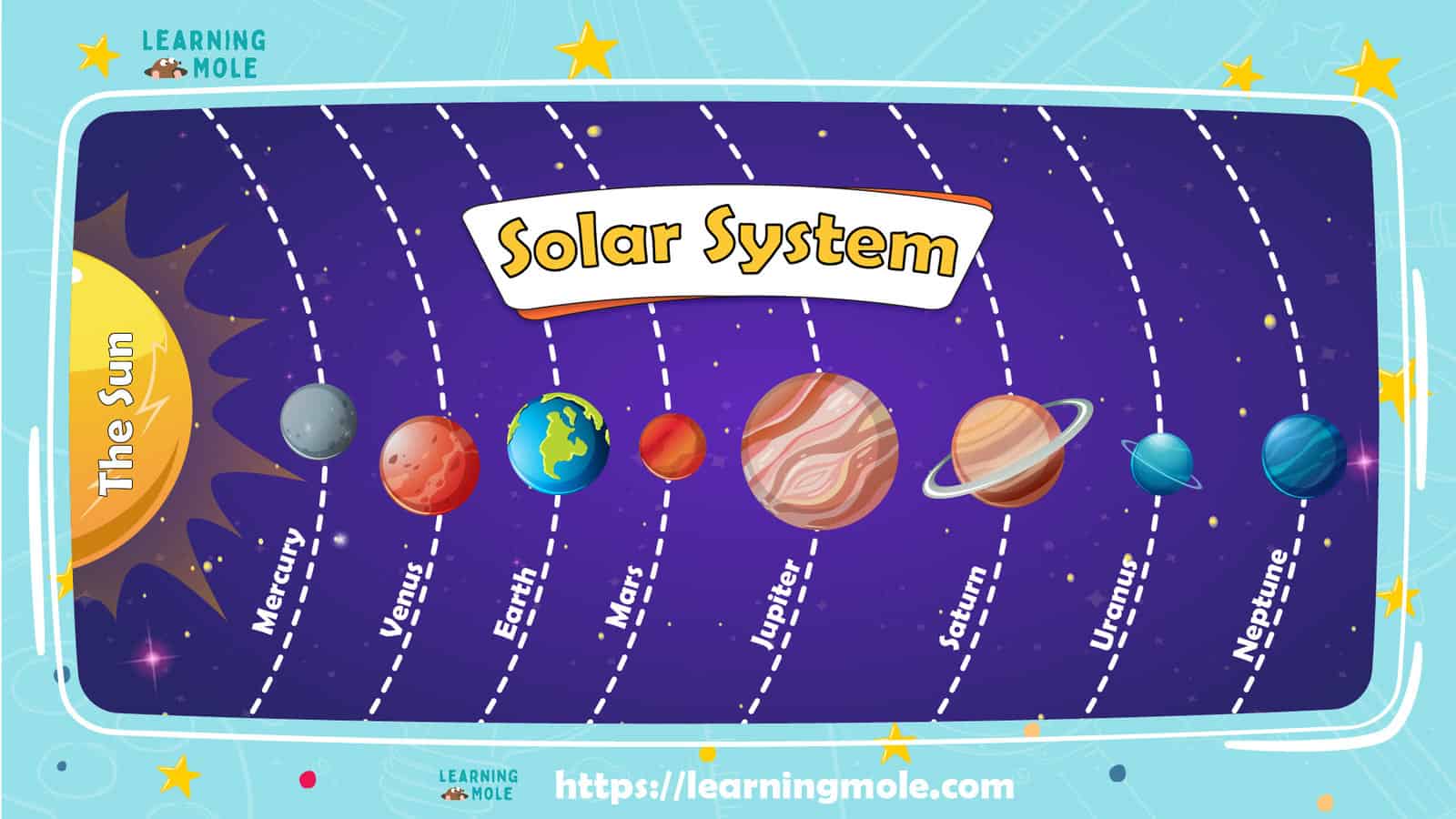
Our system is called the ‘solar’ system because our star, the Sun, is called ‘Sol’ in Latin. The Sun is the center of our solar system, and its great gravity pulls all the planets, comets, and asteroids towards it. But rest assured, these do not ‘fall’ into the sun, they simply orbit it, thanks to gravity.
Quick fact! Our Sun is just one of the millions and millions of stars that wander within our cosmic galaxy!
The solar system itself is just a tiny part of our galaxy that is called the Milky Way galaxy. Our solar system orbits the center of our galaxy once every 225 years. Our galaxy gets its name from how it looks. If you look at the Milky Way in a very unpolluted night sky, you can see that it’s shaped like spilled milk. The name ‘Milky Way’ is taken from the Romans, who used to call it ‘via lacteal,’ which means ‘milky way/road.’
The Sun
The Sun rises every day, and it provides us with light and warmth. But how long has the Sun been doing that? Our Sun has been up in the sky for about 4.5 billion years. Pretty old, right? Scientifically speaking, this is an average age for stars. Our Sun is a relatively young star, compared to our galaxy, which is 13.5 billion years old!
Our Sun is an enormous ball of hot helium and hydrogen. It is basically a boiling hot ball of gases. The Sun’s core, which is the hottest part of it, has a temperature of 27 million degrees Fahrenheit (about 15 million degrees Celsius)! Though the Sun is the closest star to our home, the Earth, we are not too close to it. In fact, the Sun is approximately 93 million miles away from Earth! So, it is close enough to provide us with the necessary warmth and solar energy. And this is why our Sun is so vital for us and all living creatures on Earth.
Our Sun’s gravity holds the solar system together. It keeps the planets, dwarf planets, moons, comets, asteroids, and more in orbit around it. When the Earth completes one cycle orbiting around the Sun, it completes one year.
The Earth also rotates and spins around itself. Our Earth takes 24 hours to spin around its axis, and this is what we call a ‘day’! That is why there are times when you see the Sun in the sky, which we call daytime, and there are other times when the sky is dark and you can see the moon, which we call nighttime. The length of daytime and nighttime changes over the year. This is why, in summer, the daytime is longer, and, in winter, it is shorter. It depends on where you live. So, let’s say that you’re starting your day where you live. In another country, it would mean nighttime for them. Pretty amazing, right?!
Like all stars, our Sun will eventually die. A star dies when it uses all its fuel, which is hydrogen. When it starts to die, the star will expand into a red star. When our Sun expands into a red giant star, it will become so big that it would swallow up Mercury and Venus, and probably Earth. It will then become a crystal white dwarf. But no worries! Our scientists say that our Sun is a little less than halfway through its lifetime and will last another 5 billion years before it becomes a white dwarf.
The Planets
Now that we have talked about our Sun, let us explore the unique 8 planets that orbit it!
Mercury
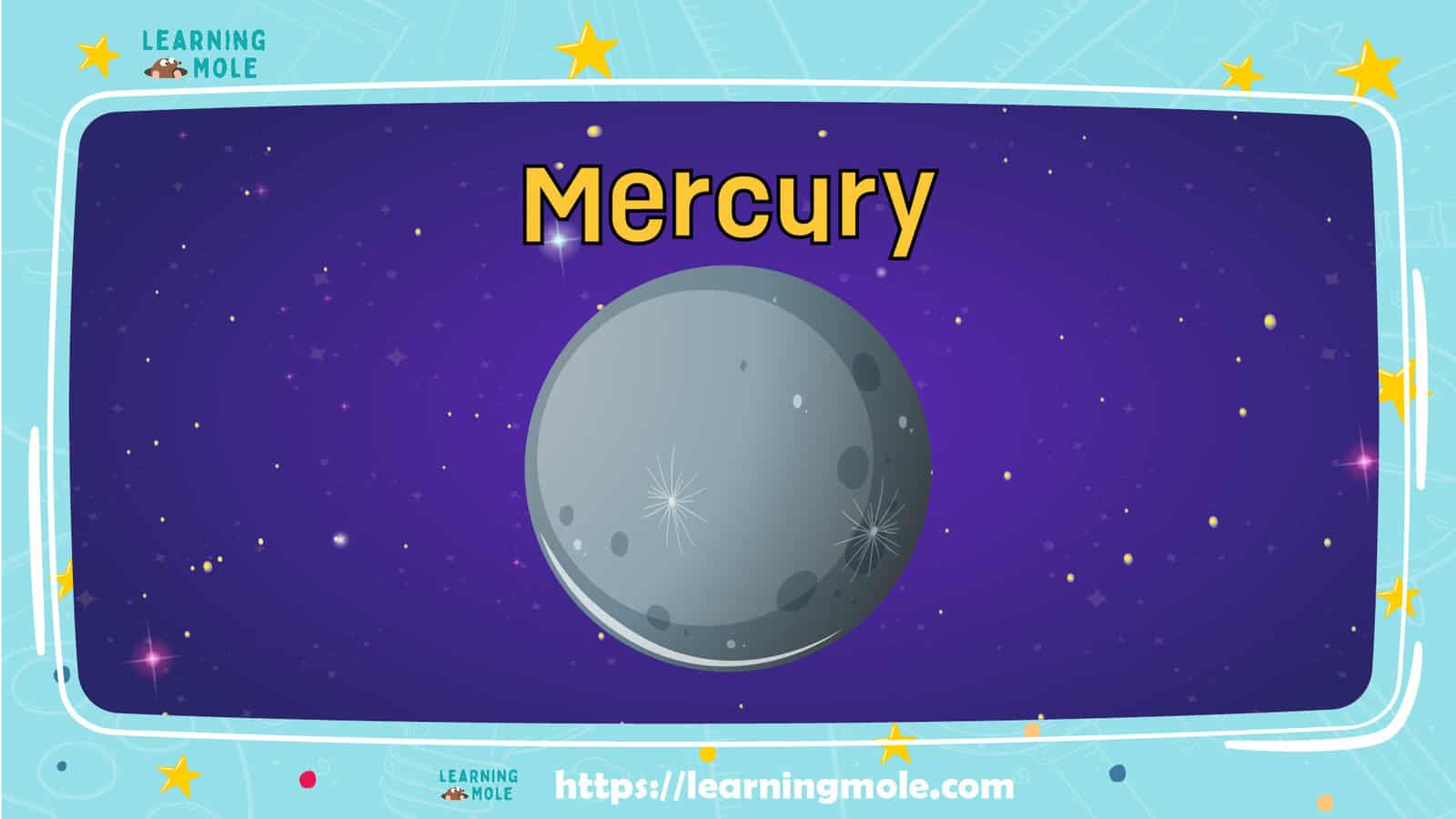
Did you know that Mercury is the smallest planet in our whole solar system? It is also the closest of our planets to our Sun. If you look at our Sun while you’re on Mercury, it will appear three times bigger than how it looks from our Earth! You might think that, since Mercury is the closest to our Sun, it must be the hottest. But that’s not true! The hottest planet in our solar system is Venus, and we will talk about it more in the next section.
Because it is so close to the Sun, it takes Mercury 88 days to complete its cycle around the Sun. So, a year on Mercury would last for only 88 days. However, the day on Mercury is much longer than our Earth day. Mercury takes 59 Earth days to complete one orbit around its axis.
Because it is so close to the Sun, it takes Mercury 88 days to complete its cycle around the Sun. So, a year on Mercury would last for only 88 days. However, the day on Mercury is much longer than our Earth day. It takes Mercury 59 Earth days to rotate around its axis.
Mercury is one of the terrestrial planets. A terrestrial planet is a rocky planet that has a hard surface and a metal core. Earth, Mercury, Venus, and Mars are all considered terrestrial planets.
Mercury doesn’t have any moons. It also doesn’t have any rings around it. And it looks so much like our own moon. It has a greyish-brown color and bright streaks on its surface called ‘crater rays.’ Crater rays are formed when comets or asteroids hit the surface of a planet or a moon.
As Mercury is the fastest planet to orbit the Sun, its name has an interesting story behind it. ‘Mercury’ was the name of one of the Roman gods. He was a messenger and known as the god of travelers. Because of his winged hat and sandals, he could fly and was the fastest among the other gods.
Venus
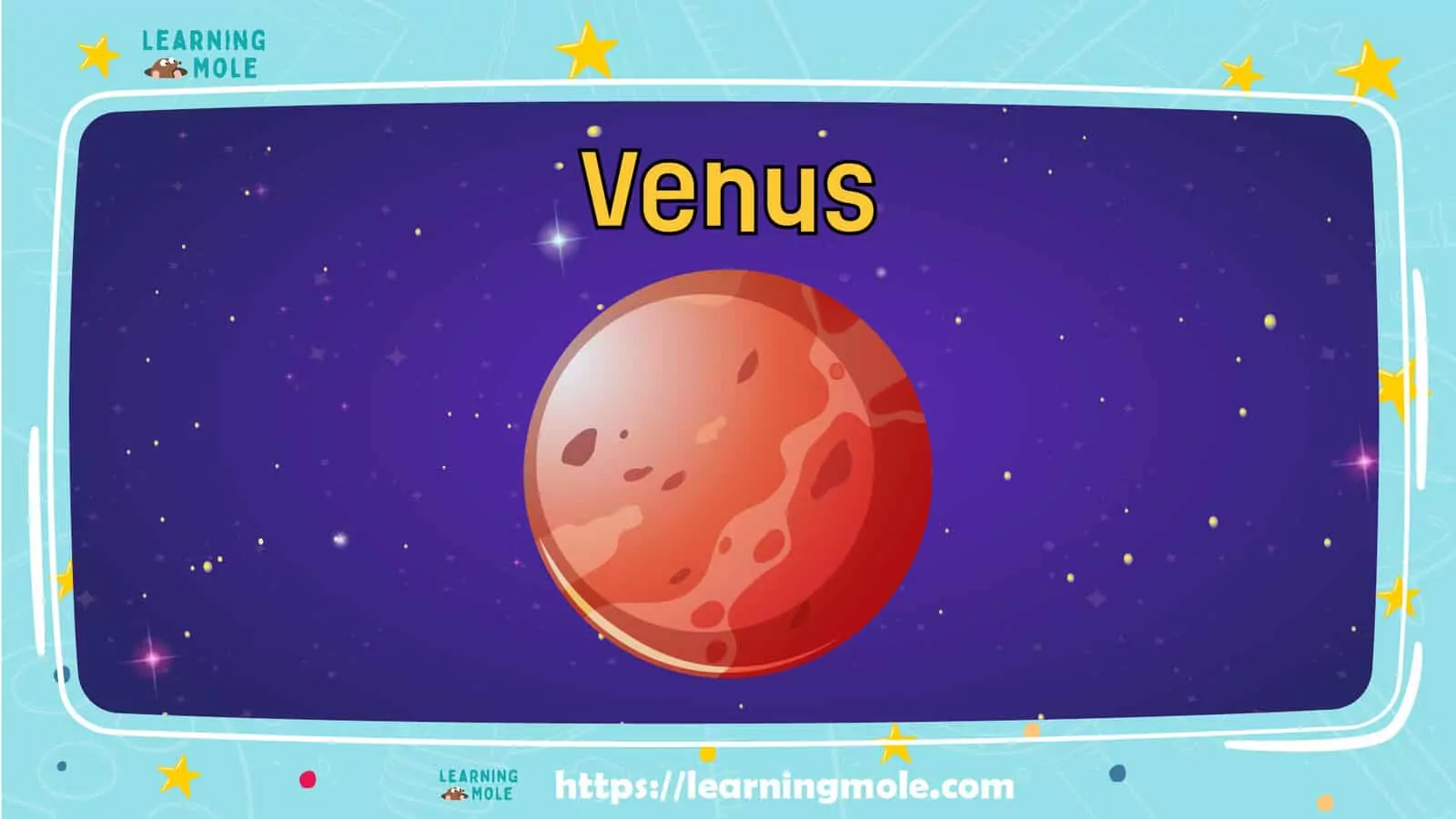
Venus is the second closest planet to the Sun, and it is our Earth’s neighbor. Venus is a terrestrial planet as well. Although Venus is more distant from the Sun than tiny Mercury, it is the hottest planet. Venus is hotter than Mercury because of its dense atmosphere. Venus’ atmosphere is toxic and is filled with carbon dioxide. It is also covered with yellow clouds of sulfuric acid that trap heat and make an enormous greenhouse effect. Surface temperatures on Venus are about 900 degrees Fahrenheit (475 degrees Celsius), which is enough to melt lead. Venus is also believed to have volcanoes. And this is why scientists believe that it would be most unlikely to be able to live on Venus.
Due to the similarity in size and mass with the Earth, Venus is often called the Earth’s twin. However, in reality, they are so different from each other. One of the reasons why Venus is very different from Earth is because of its high temperature. Another difference is that Venus rotates backward. And a day on Venus would not equal a day on our Earth. A day on Venus lasts for 243 Earth days. Whereas a year on Venus would be only 225 Earth days. This means that a day on Venus is longer than a whole year on it!
Even though it is called the Earth’s twin, Venus does not have any moons. One interesting fact about Venus is that scientists cannot determine what color it is. To the human eye, Venus appears to be white and yellow, with a reddish and brown surface. We see yellow strips because of the sulfur in Venus’ atmosphere. And because Venus rotates backward, if you are to be on it, the Sun would rise in the west and set in the east, opposite of what we see on our Earth.
Because ancient Romans could easily see the seven brightest objects in the sky, they named the objects after their most important gods. Like Mercury, Mars, Jupiter, and Saturn, Venus is named after one of the goddesses of Roman mythology, the goddess of love and beauty, Venus.
Earth
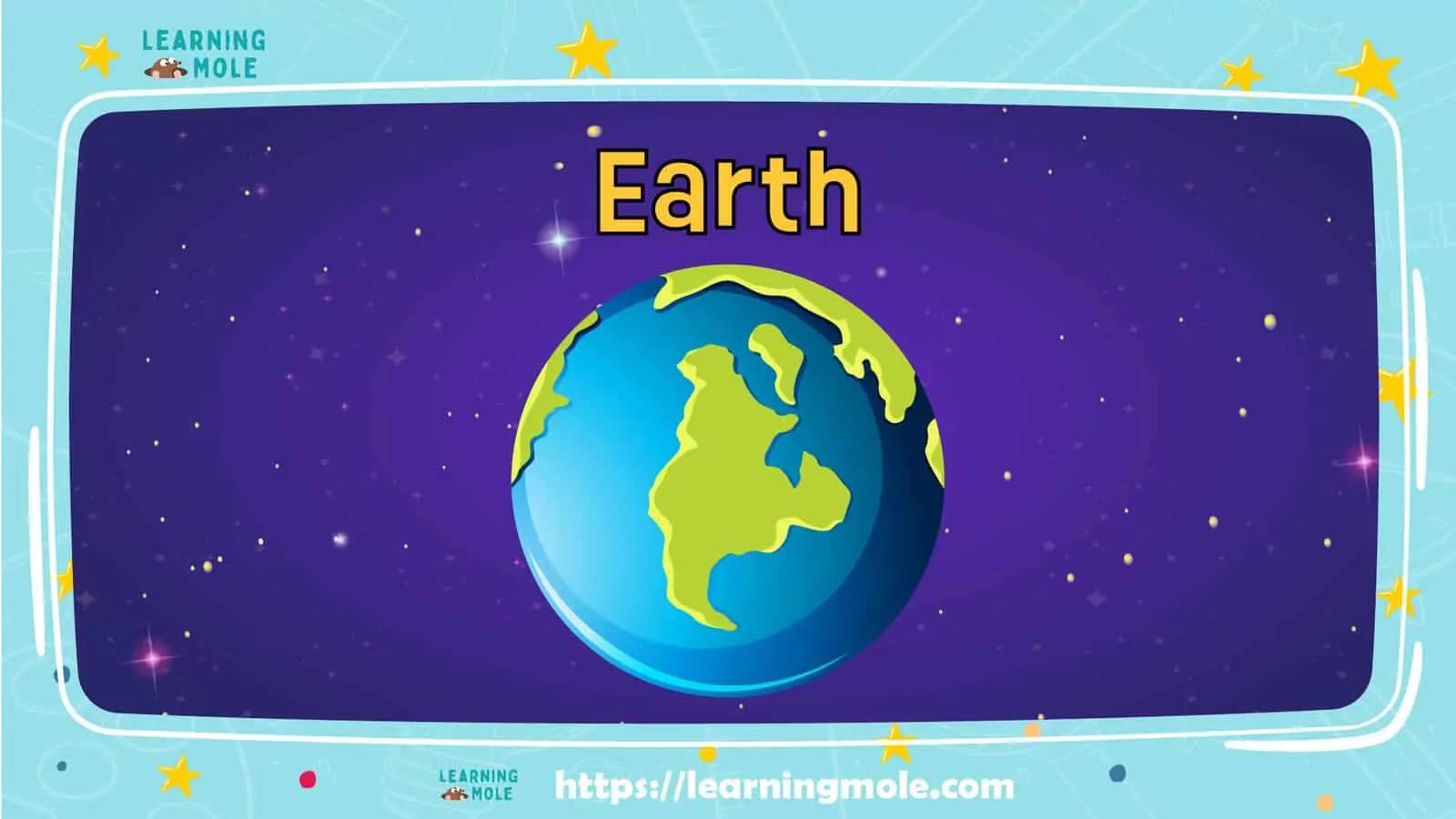
Now, let’s talk about our home planet, the Earth!
Earth is the third planet from the Sun, the fifth largest planet in our solar system, and the only planet we know of that humans can live on. Earth is the third and biggest terrestrial planet. Earth is considered the only planet to have liquid water on its surface. Around 71% of the Earth is covered by water and only 29% by land. 97% of Earth’s water is salted water, which makes up our oceans. Only 3% of the water is freshwater that we can use to drink. This freshwater comes from rivers, lakes, and groundwater. With this much water on its surface, the Earth has earned its nickname ‘the Blue Planet.’
Earth has a more unique atmosphere than any other planet. The atmosphere consists of 78% nitrogen, 21% oxygen, and 1% other gases, such as carbon dioxide and argon. The amount of oxygen might seem so little for all of us to breathe, but it is just the right amount. Earth’s atmosphere also plays an important part to protect and shield us from the harmful radiation coming from the Sun. It also protects us from coming meteoroids. When a meteoroid burns up in our atmosphere, it is displayed as a ‘shooting star’ that we all see in the night sky. This is called a meteor. If a meteoroid survives and does not burn up, it hits the ground and is called a meteorite.
It takes Earth 24 hours to spin around its axis. We call this a ‘day.’ When Earth completes one cycle of orbiting the Sun, we finish one year. One year on Earth lasts exactly 365.25 days.
Fun fact! The extra quarter of the day means that every four years, we add one day to our calendar. When this happens, we call this day a ‘leap day’ and the year it is added to is called a ‘leap year.’ And this is why we sometimes see on our calendar that February has 29 days instead of 28!
Since Earth is one of the terrestrial planets, we know that it has a metal core. Earth’s core is made up of mostly iron and nickel. It is so hot at the Earth’s core that these metals are all in liquid form.
Earth is the only planet to have one single moon. Our moon is our only natural satellite. A satellite is an object that orbits a planet or a star. We have many superficial satellites, but our moon is the only one that is naturally lovely.
Our moon is the brightest object we see in our night sky. Its light guides us in the night and makes our night sky more beautiful. However, the moon is not naturally bright. The reason our moon is so bright is that it reflects the light that is coming from the Sun.
The name ‘Earth’ is a 1,000-year-old name. Our Earth is the only planet that is not named after Greek and Roman gods and goddesses. The word ‘Earth’ comes from the Germanic word ‘erde’ and the old English word ‘ertha,’ and they both mean ‘ground.’
You would think that since we are living on Earth, we would know everything about it. That is not true. There are so many mysteries about our home planet that we are yet to discover!
Mars
Now we move on to the next planet! The famous ‘Red Planet!’ Mars is called the Red Planet because of rusting (which is also called oxidation) of the iron minerals that are found in Mars’s soil, making the surface look red. Mars is probably the easiest to spot in a clear night sky –it is a bright red dot! Mars has a thin atmosphere and is one of the four terrestrial planets. This means that it is rocky. Mars is the second smallest planet. It is actually half the size of Earth.
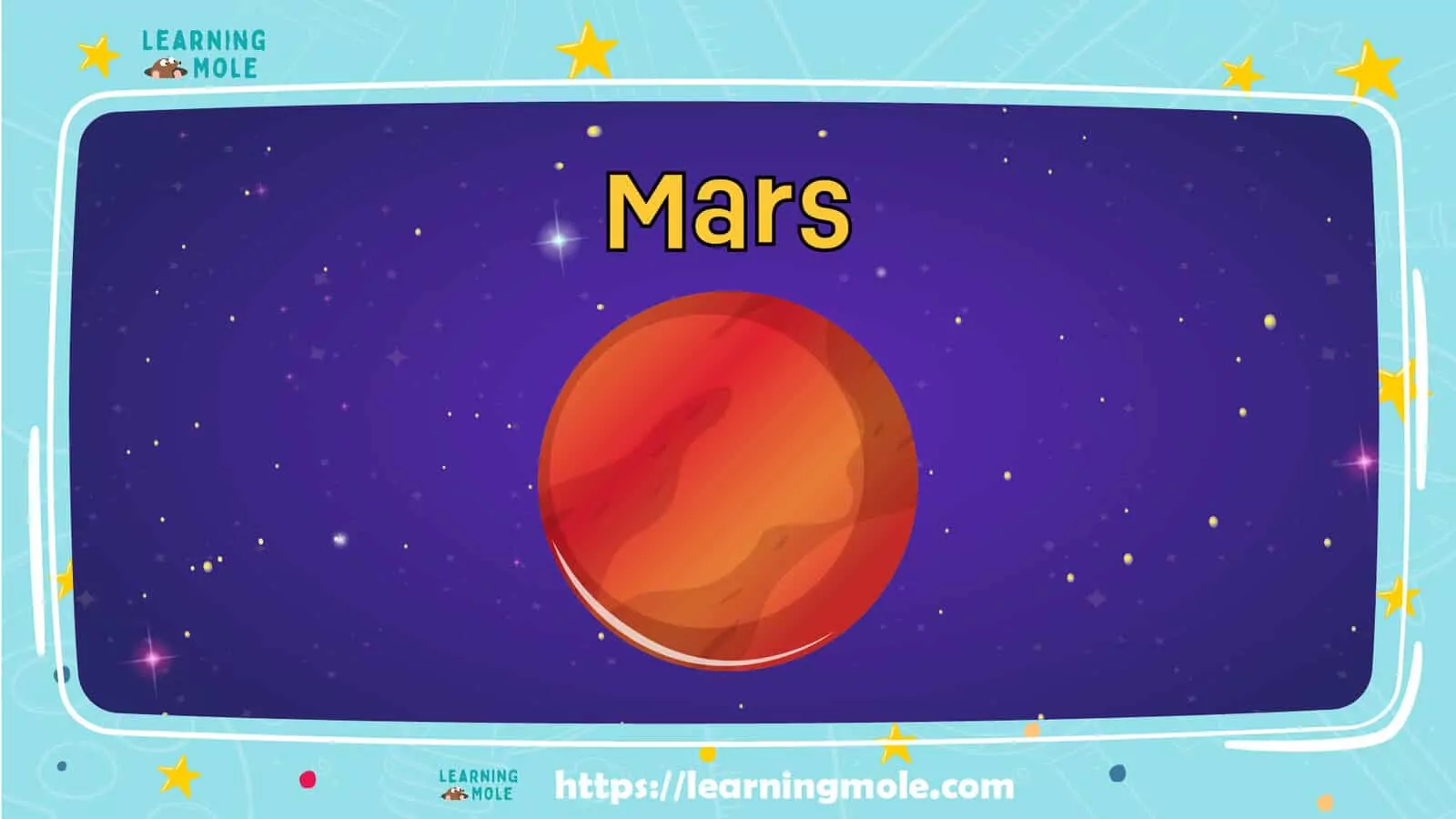
The name ‘Mars’ also has a little bit of reddish story to it. As mentioned before, the ancient Romans could easily spot the brightest objects in the sky, and Mars was one of them. Its reddish color reminded them of the blood that was shed in wars. So, they named Mars after their war god.
The day on Mars is 24.6 hours long, which is a little longer than Earth’s day. Because of its similarity with the day on Earth, Martian days are called ‘sol days,’ short for ‘solar days.’ A year on Mars lasts 669.6 sols, which equals 687 Earth days.
Mars has a thin atmosphere made up mainly of carbon dioxide, nitrogen, and argon gases. Unlike the Earth’s sky, Mars’ sky would look reddish, and that is because of the particles of suspended dust. Mars’ atmosphere also differs from Earth’s in one more characteristic. Mars’ atmosphere does not offer protection from comets, asteroids, and meteorites.
You might wonder about the weather on Mars. It appears that Mars is much colder than Earth. Because Mars’ atmosphere is too thin, the heat coming from the sun easily escapes this planet. The temperature on Mars can get as high as 70 degrees Fahrenheit (20 degrees Celsius). And it can drop as low as -225 degrees Fahrenheit (-153 degrees Celsius).
The wind on Mars is not very pleasant. It can get strong enough to create dust storms that cover the whole planet. It can take months before all the dust can settle.
One of the most interesting findings on Mars is Olympus Mons. Olympus Mons is the tallest and largest volcano/mountain in the solar system. It is three times taller than our Mt. Everest! Gigantically large, right?!
There has been evidence that Mars once had water. It is geologically known that where there is water, there would be traces left on the landscape. Flowing water carves out riverbeds, and this is exactly what a NASA rover has found when sent on a mission to explore any traces of water on Mars.
Now let’s move on to moons. Mars has two small moons named Phobos and Deimos. These moons are named after the sons of the Greek war god, Ares (Mars to the Romans). The two moons look like potatoes!
The moon Phobos is heavily cratered. This means that it is impacted by a lot of hitting comets, asteroids, and meteorites. According to NASA, Phobos is moving towards Mars slowly. It will eventually crash into Mars or break apart in about 50 million years.
Like Phobos, Deimos is a heavily cratered moon. It is about half the size of its brother, Phobos. Although you would think that Deimos would look like it has deep craters, it actually looks very smooth. This is due to the loose dirt that fills up the craters. It is unlikely that Deimos would crash into Mars, like Phobos, because it orbits farther away from the planet.
You might be wondering: “how do we know all this stuff about Mars?!” Mars is actually the most explored object in our solar system. It is the only planet that we have sent rovers to explore. NASA currently has two rovers on Mars. One is named ‘Curiosity’ and the other is named ‘Perseverance.’ Perseverance’s mission is to look for signs that could tell us if Mars had any form of life. UAE and China have also sent robotic machines to explore the alien planet. NASA believes that it might be possible to launch a man-led mission to Mars by the 2030s.
Jupiter
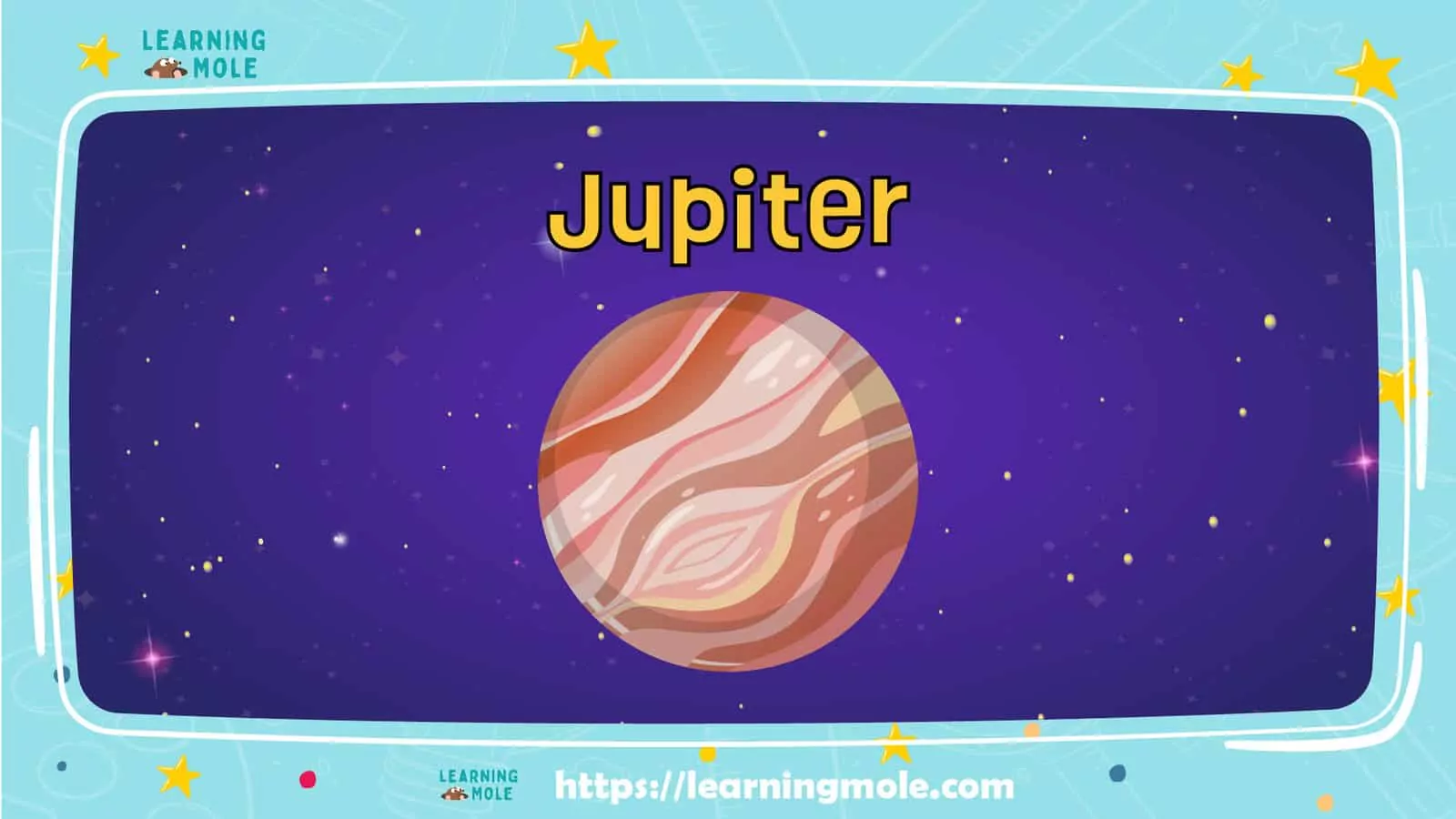
Next, we have the biggest planet in our solar system, Jupiter! Jupiter is so big that it is twice as massive as all the other planets combined. Jupiter is one of the Jovian planets, along with Saturn, Uranus, and Neptune. A Jovian planet is composed entirely of gases, mostly hydrogen and helium. Jovian planets do not have solid surfaces like terrestrial ones. But scientists think that Jupiter’s core may be solid and is about the size of the Earth.
When the solar system was formed 4.5 billion years ago, Jupiter took most of the mass that was left from forming the Sun, making it twice as massive as all the other planets combined. Although Jupiter has the same materials found in a star (helium and hydrogen), it didn’t become a star. It was not big enough to ignite as a star.
The stripes you see on the surface of Jupiter are clouds of ammonia and water. The big red spot that we see when we look at pictures of Jupiter is a violent storm that has been going on for hundreds of years. Jupiter also has rings, like other Jovian planets, but they are too faint to see. They are like rings made of dust!
Jupiter is so big that its name has a significant meaning behind it. Because Jupiter is the biggest planet in our solar system, it was named after the king of the ancient Roman gods. In Greek, Jupiter is called ‘Zeus,’ who is the father of all Greek gods.
Jupiter has the shortest day in our solar system. It takes Jupiter only 10 hours to spin around its axis. While it has the shortest day, Jupiter has one of the longest years in our solar system. It takes Jupiter 12 Earth years to orbit the Sun.
One of the interesting facts is that Jupiter has the largest ocean in our solar system. However, it is not an ocean made of water. It is an ocean made of liquid hydrogen. Due to its thick atmosphere, the temperature and pressure are huge, and they turn the hydrogen gas into a liquid.
Unlike Earth and Mars, Jupiter has many moons. The moons are so many that it is often said that Jupiter forms its own solar system. Jupiter has 53 confirmed moons and 26 moons that are still awaiting confirmation. Jupiter has four large moons -they are the largest-. Each moon is unique on its own and we will explore them in the Moons section here. These four moons are named: Io, Europa, Ganymede, and Callisto.
Spacecraft, probes, and orbiters observed the giant planet such as Pioneer 10 and 11, New Horizons, Cassini, and Juno. Juno is the latest spacecraft that landed on Jupiter to study Jupiter’s chemistry and atmosphere. So, there are still many things to know about Jupiter in the future!
Saturn
We will now begin talking about the most unique planet in our solar system! Saturn is the second-largest planet in our solar system, and it is the most unique-looking one. Saturn is not the only planet to have rings, but it has the most beautiful ones. Like its neighbor, Jupiter, Saturn is mostly made up of hydrogen and helium.
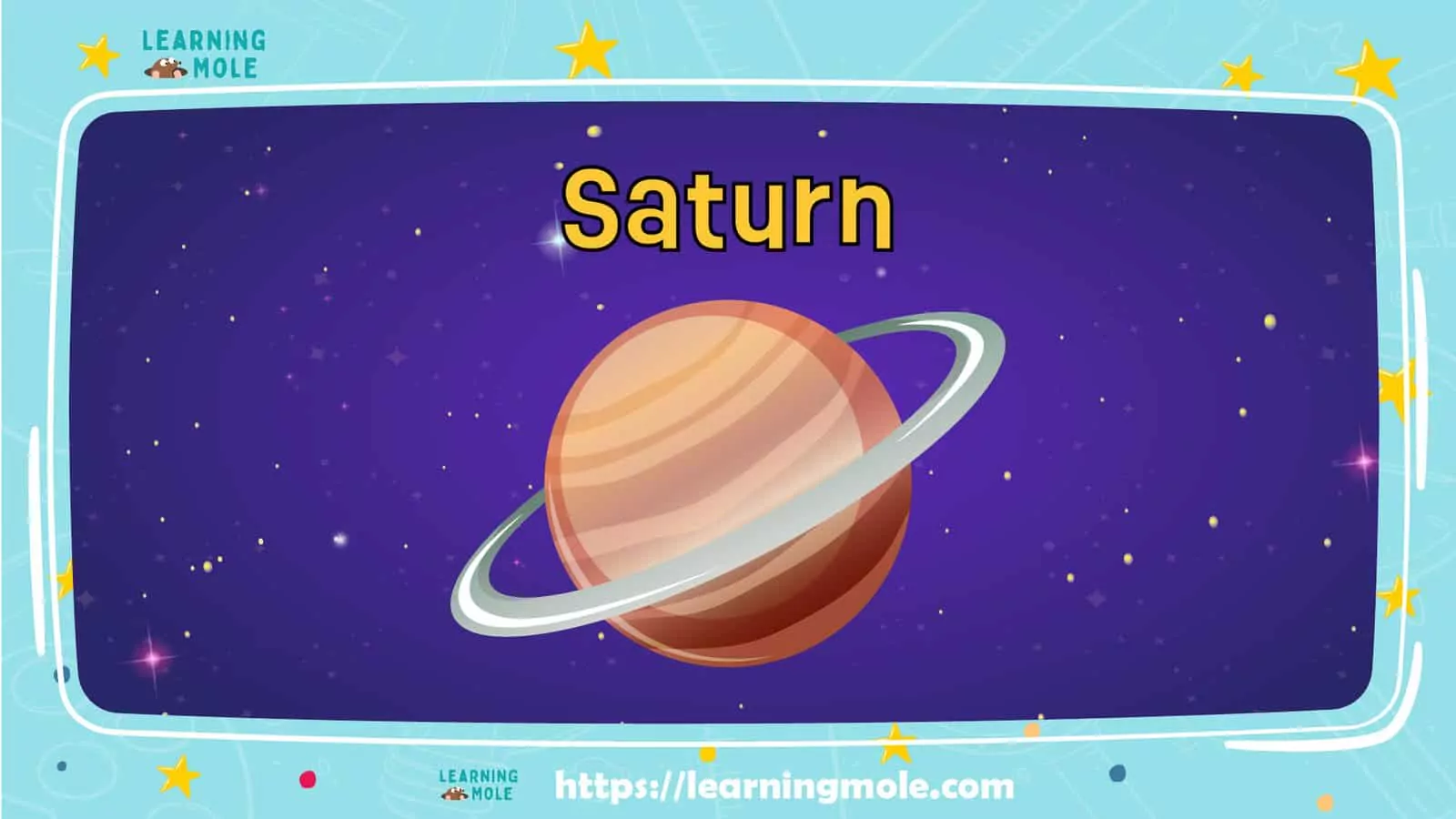
Saturn is one of the brightest objects in the night sky that could be seen easily by the ancients without a telescope. It is named after the god of agriculture and wealth in Roman mythology. This Roman god is the father of Jupiter.
Like Jupiter, a day on Saturn is pretty short. A day on Saturn lasts for only 10.7 hours. This is the time that it takes Saturn to spin around its axis. However, it takes Saturn 29.4 Earth years to orbit the Sun completely.
Saturn has 82 moons. There are 53 confirmed moons and 29 awaiting confirmation. This makes Saturn the planet that has the most moons in our solar system. We will know about Saturn’s most famous moons in the Moon section below.
When you look at Saturn’s pictures, the first thing you notice is the rings around it. They are lovely and unique, and more complex than they look. The rings around Saturn are made of billions of ice and rocks that are coated with dust. Scientists think that these small objects are pieces of comets, asteroids, and shattered moons that got torn apart by Saturn’s powerful gravity. The most interesting thing about them is the different speeds that each ring orbits Saturn at.
Uranus
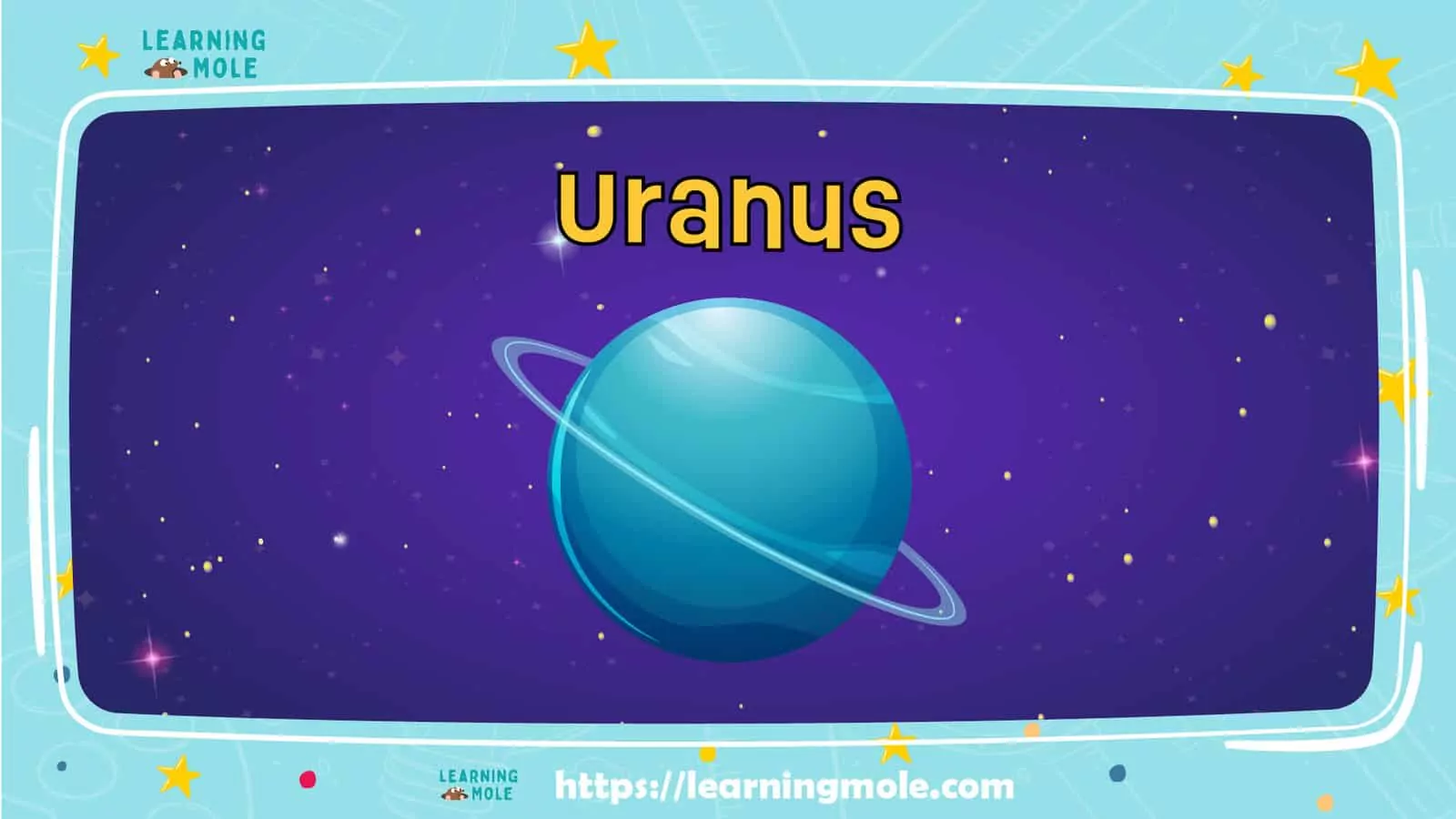
We have nearly arrived at the end of our planet journey. This planet is the coldest one in our solar system. Uranus is one of the two ice giants in our solar system (the other one is Neptune). That is because Uranus is made of a hot dense fluid of icy materials, such as water, ammonia, and methane. All of these materials are above a small hot core that heats up to 9,000 degrees Fahrenheit (4,982 degrees Celsius). Uranus does not have a solid surface. Uranus’ atmosphere is made of hydrogen, helium, and methane. The methane in Uranus’ atmosphere absorbs the red portion of the light that is coming from the Sun and reflects it as blue. And this is how Uranus gets its beautiful blue color. Uranus also has a set of 13 rings that are faint in color. The outer rings are the only ones that are bright and can be seen vividly.
Scientists think that when our solar system started to form, Uranus and Neptune were much closer to the Sun. But 4 billion years ago, they both were moved to the outer part of the solar system.
It was not possible for people in ancient times to see Uranus with the human eye. So, Uranus was named after they developed telescopes. Like the rest of the planets, scientists decided to use Greek and Roman gods’ names as well. In Greek mythology, Uranus was the sky god, father of Saturn, and grandfather of Jupiter.
One day on Uranus has about 17 hours, and this is how many hours it takes Uranus to rotate. It takes Uranus 84 Earth years to make a complete orbit around the sun. Uranus is also one of the two planets that rotate backward (the other planet is Venus). This means that the Sun rises in the west and sets in the east.
The weather on Uranus is very extreme. This ice giant has the coldest temperature ever recorded in our solar system, which is -371.56 degrees Fahrenheit (-224.2 degrees Celsius). Uranus is not the coldest planet because it is way farther away from the Sun. Uranus is the coldest because it rotates on its side. Billions of years ago, a giant object crashed into Uranus causing it to turn on its side.
Quick fact! Did you know that Uranus is the only planet that rotates on its side?
Another interesting thing about Uranus is its moons. We know that most of the natural satellites of other planets take their names from Greek and Roman mythology, right? Uranus’ moons are different. There are 27 moons in total orbiting Uranus, and they all have unique names. Each moon is named after a character from the literary works of Shakespeare and Alexander Pope.
Neptune
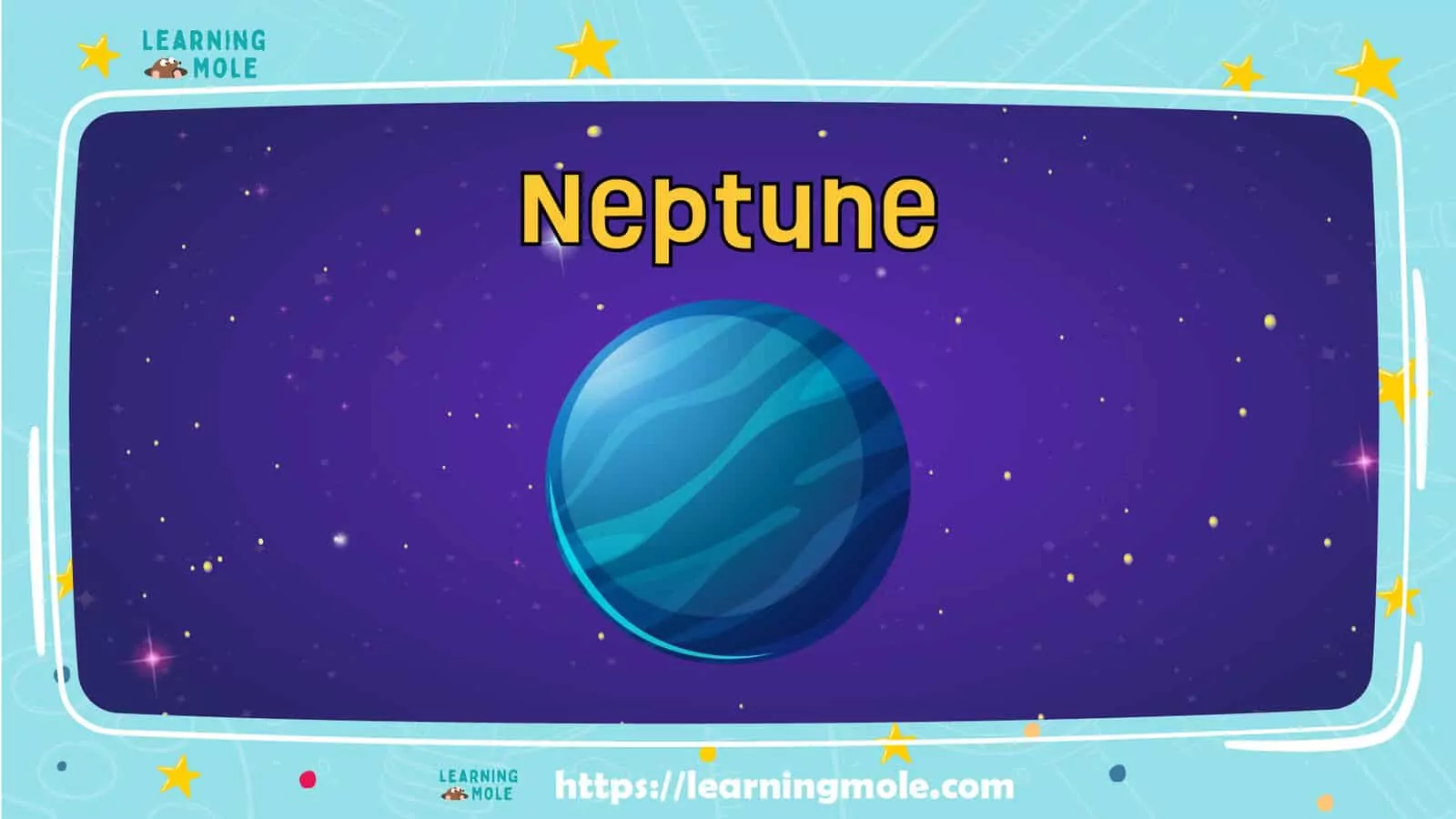
We have finally reached the last planet! Neptune is the most distant planet from the Sun. It is dark, cold, and has the most violent winds. It is an ice giant, just like its neighbor Uranus. It is mostly made of a hot dense fluid of water, methane, and ammonia. All of these materials exist above a small hot core. Like Uranus, Neptune does not have a solid surface. Its atmosphere is so big that it merges with water and icy materials. Neptune’s atmosphere is mostly made of hydrogen, helium, and methane. Again, like Uranus, the methane in Neptune’s atmosphere absorbs the red portion of the light that is coming from the Sun and reflects it as blue.
When you look at space photos taken of Neptune, its blue color reminds you of the blueness of the sea, right? Its beautiful blue color is the reason behind its unique name. Neptune was the sea god in Roman mythology. Because of the similarity between Neptune’s color and the blue color of the sea, scientists picked ‘Neptune.’ And it is truly the perfect name for it!
The time it takes Neptune to rotate once is 16 hours. That means that a day on Neptune lasts only 16 hours. However, a year on Neptune is so long. Neptune makes a complete orbit around the Sun every 165 Earth years. That’s a lot of time to wait for your birthday!
Fun fact! In 2011, Neptune completed its first orbit around the Sun -165 Earth years- since the planet was discovered in 1846.
Neptune has 14 moons. They are all named after minor Greek gods and nymphs. One of these moons is called Triton and it is the largest moon that orbits Neptune. We will know more about the moon Triton in our Moon section below.
Moons
The next objects we are moving on to are moons! Although Mercury and Venus do not have moons, we are going to explore other planets’ moons, starting from Earth to Neptune.
But first, let’s talk about how moons were formed. A moon, also called a natural satellite, orbits planets in our solar system. Some moons are big, and some are so small. Moons are mostly formed from the gas and dust that were around the planets when the solar system was beginning to be formed. However, it is believed that some of these moons are ‘captured’ objects that were formed elsewhere and fell to orbit the planets.
Earth’s Moon
First on the list is our lovely Moon! The Moon is the only place beyond Earth that humans set foot on. In fact, there are 12 humans who have visited the Moon. It is so easy to spot in the night sky! It illuminates our nights and makes a great companion for us in the night.
Our Moon is our only natural satellite. It is the fifth-biggest moon in our solar system. Scientists believe that the Moon was formed after Earth and Mars crashed into one another millions of years ago. This resulted in the tearing of a piece of Earth’s molten rock. This molten rock cooled down until it formed the Moon that we see in our night sky.

The Moon takes 27.3 days to make an orbit around Earth while also completing one orbit around its axis. Because of this, we only see the same side of the Moon. You might think that the Moon has its natural light because it appears so bright in our night sky. However, this is not true. The Sun reflects its sunlight upon the surface of our Moon, making it bright and dazzling. People have mistakenly called the other side of the Moon that we can’t see ‘the dark side.’ This is not true. The sunlight is reflected on every side of the Moon, but we only see the same side because the Moon orbits its axis at the same time it orbits the Earth.
On some days, we see the Moon shrinking and on other days we see it getting bigger until it reaches the full bright moon that we see. The Moon is actually the same size as always, we just view it differently. Depending on how much sunlight the Moon gets, it goes through phases. When we cannot see the Moon, it means that it is in its New Moon phase. If people in the countries of the Northern Hemisphere see a thin crescent of light on the right side of the Moon, it means that it is in its Waxing Crescent phase. When we see a half-moon, it means that it is the First Quarter phase. When we see that the Moon is between a half-moon and a full moon, this is called the Waxing Gibbous phase. Waxing means that the Moon is getting bigger (that is what appears to us). When we can see the Moon fully bright in our night sky, we call it the Full Moon phase. When the Moon is in its Waning Gibbous phase, we see that it is between a half-moon and a full moon. Waning means that the Moon is getting smaller in our eyes. In the Third Quarter phase, we see a half-moon, but it is the opposite half as compared to the half shown in the First Quarter phase. When people in the countries of the Northern Hemisphere see a thin crescent of light on the left side of the Moon, it means that it is the Waning Crescent phase.
Our Moon is responsible for tides! Tides are the change in the water level in the oceans. Because of gravity, the Moon and the Sun pull on Earth. And this causes tides. The Moon has got the bigger responsibility because it is closer to our Earth.
Mars’ Moons
Mars has two small moons called Phobos and Deimos. They look like asteroids and many people think that they were once in the asteroid belt and were pulled by Mars’ great gravity.
Phobos orbits so close to Mars that it orbits the Red Planet three times a day! Scientists believe that Phobos will eventually crash into Mars when it dies.
When we look at pictures of Phobos, it really looks like a potato. It has many craters and that is because of the many hitting asteroids, comets, and meteorites.
Deimos looks like another potato! But its surface appears much smoother than that of Phobos because of the dust that is filling its craters. It is smaller than Phobos and orbits farther away from Mars.
Jupiter’s Moons
Jupiter is one of two planets (the other one is Saturn) that have the most moons in our solar system. Jupiter has 79 moons in total. It has 53 named moons and 26 awaiting their names. We will be talking about the four largest moons that orbit Jupiter, the Galilean Moons. They are called the Galilean Moons after the Italian astronomer Galileo Galilei, who first observed them in 1610. These moons are bigger than our Moon and are named Io, Europa, Ganymede, and Callisto.
Io is known to be the only object that has many active volcanoes in the solar system. Io is one of the most colorful celestial bodies in our solar system. This is due to the sulfur and sulfur compounds on its surface. It has no water on it, unlike the other Galilean moons. Io is named after a maiden who was loved by the Greek god Zeus and was turned into a cow during a dispute between Zeus and his jealous wife Hera.
The next moon on the list is called Europa. Europa is one of the most interesting worlds to explore because scientists found suitable environments for some form of life on it. From observations, scientists found that Europa’s surface looks like a sea of crushed ice. Scientists believe that beneath this layer there might exist an ocean that may contain twice as much water as all of our oceans combined. Europa was named after a princess who was abducted by Zeus (Jupiter, in Roman mythology) to be his lover.
Our next moon is called Ganymede. It is the biggest moon in our solar system. Exploring Ganymede is important to scientists because NASA’s Hubble Telescope found evidence of an underground saltwater ocean on it. Scientists think that this ocean will have more water than the water on Earth’s surface. Not only this, but scientists have found that Ganymede’s thin atmosphere contains small amounts of oxygen. This moon is named after a young boy who was carried to Olympus by Zeus and made the cupbearer of all the gods.
Our last big moon is Callisto. Callisto is Jupiter’s second-biggest moon and the third biggest one in our solar system. It was once thought ‘dead.’ However, in the 1990s, it was discovered that it may have a salty ocean beneath its surface. This made Callisto on the list of the worlds that may have some sort of life on it. Callisto is named after a woman who was Zeus’ lover. When Hera found out about their relationship, she turned Callisto into a bear.
Saturn’s Moons
Now, we are going to explore the moons of our beautiful Saturn. Saturn has 82 moons, making it the possessor of the largest number of moons in our solar system. We will explore two of Saturn’s most famous moons!
The first moon is called Titan. It is the second-largest moon in our solar system. It is the only moon in our solar system that has clouds and an atmosphere like our planets. Its atmosphere is made mostly of nitrogen, like our atmosphere. Titan’s surface is made of water ice as hard as a rock. However, scientists believe that beneath its surface there is an ocean of liquid water. Titan takes its name from Greek mythology. A titan was a member of a family of giants that used to rule the world before the Olympian gods.
The next moon is called Enceladus. Enceladus has the whitest and loveliest surface in our solar system. Wouldn’t it be incredible if we could live on such a beautiful planet? In fact, scientists think so! Enceladus makes it easy for us to examine it. It has an icy ocean, and it sprays icy particles in space. One of our spacecraft has got samples from these particles and examined them. Scientists found out that Enceladus has most of the chemical ingredients that are needed for life.
Uranus’ Moons
Uranus has so many moons! It has the biggest number of moons in our solar system. All of the discovered moons are named after characters from the works of the playwright Shakespeare and the poet Alexander Pope. Uranus has five large moons, and they are Titania, Oberon, Ariel, Umbriel, and Miranda. Titania is the largest of them and Miranda is the smallest. These moons are made of rock and water ice. Many small moons exist between these large moons, and they are almost like asteroids! But thankfully, they do not crash into one another.
Neptune’s Moons
Neptune has 14 moons but the most distinguished one is Triton. Triton is the largest of Neptune’s moons. Scientists think that Triton was formed in the Kuiper Belt but was pulled by Neptune’s gravity. Triton is special because it is the only moon in our solar system that orbits in the opposite direction of its planet rotation. This is called a retrograde orbit. Triton is named after Poseidon’s son (Poseidon is Neptune in Greek mythology).
Dwarf Planets
Our next stop is all about dwarf planets! Dwarf planets are too small to be considered planets, but they are not that small to be considered any other small celestial body, like asteroids for example. Another reason why they are not considered planets is because their orbit has other small objects. A planet’s gravity can push these small objects out of its orbit. However, dwarf planets do not have a powerful gravity.
We are sure you’ve heard about the dwarf planet Pluto, but they are other dwarf planets that we are going to explore here!
Pluto
Pluto is the most well-known of the dwarf planets. This is because it used to be the ninth planet in our solar system! But when scientists found out more about Pluto and other objects as small as it, they removed poor Pluto from the list of planets. But worry not! Even though it is not a planet, Pluto is a fascinating world for us to explore. It is smaller than our moon and it has a cute spot that looks like the heart of its surface!
One day on Pluto is about 153 hours long, that’s too long for a day! And a year on Pluto lasts 248 Earth years. A long time to wait for your birthday, right?
Pluto exists inside the Kuiper Belt. Although Pluto is very far away from the Sun and was considered the ninth planet, it sometimes was closer to the Sun than Neptune. Pluto also has its own moons. It has five moons and its largest one is called Charon.
Fun fact! Pluto was named by an eleven-year-old English girl! She picked its name from Roman mythology. Pluto was the name of the underworld god.
Ceres
The next dwarf plane that we are going to visit is Ceres. Ceres exists in the asteroid belt. The asteroid belt is a place between Mars and Jupiter that has most of the asteroids in our solar system. Ceres was once considered an asteroid, but scientists thought that it was way too big to be considered one. However, it is considered the smallest of the dwarf planets. Another difference between Ceres and asteroids is that it does not look like a potato! Ceres actually has a round body.
A year on Ceres is only 4.6 Earth years long. But Ceres has one of the shortest days in our solar system. It takes Ceres only 9 hours to spin around its axis. Unlike other dwarf planets, Ceres does not have any moons.
Ceres is one of the objects that scientists want to explore for any potential of life. In one of the missions, it was spotted that Ceres has water vapor. This means that it has water! And we know how water is important for life. That is why scientists plan to send missions to Ceres in the future.
Fun fact! Ceres is named after the corn and harvest goddess in Roman mythology. The word ‘cereal’ also comes from the same name.
Makemake
Our next stop is a bright dwarf planet, Makemake. Makemake is the second brightest dwarf planet, after Pluto, that could be observed by a telescope. Makemake is a very important object in space history. It was one of the objects, along with Eris, that were discovered that made Pluto get kicked out from being the ninth planet. Its discovery made scientists create a whole category just for these objects that were smaller than the rest of the planets. Makemake is inside the Kuiper Belt. Makemake has no atmosphere. However, when it is the closest to the Sun, it develops a thin atmosphere. A day on Makemake is 22.5 hours long, which is slightly shorter than a day on Earth. However, it takes Makemake 305 Earth years to orbit the Sun. Makemake is named after the fertility god in Rapa Nui mythology.
Huamea
Our next dwarf planet is a fast one! Haumea is in the Kuiper Belt. Haumea is the same size as Pluto, but it has a weirdly oval shape. Haumea is one of the fastest rotating objects in our solar system. It only takes Haumea 4 hours to spin around its axis. However, a year on Haumea is 285 Earth years long. Haumea is the second dwarf planet to have more than one moon, after Pluto. It has two moons named Namaka and Hi’iaka. Haumea is named after the Hawaiian goddess of fertility.
Quick fact! No spacecraft has ever visited Haumea or traveled past it. Everything we know about this dwarf planet is from observations with telescopes.
Eris
We have finally arrived at our last dwarf planet, Eris. Eris is about the size of Pluto that it is nicknamed ‘Pluto’s almost perfect twin.’ Eris is also a very important object because it made scientists reconsider Pluto as a planet. It takes Eris 557 Earth years to orbit the sun, but the length of its day is similar to ours. Eris takes only 25.9 hours to spin around its axis. Eris is named after the goddess of chaos in Greek mythology. Eris has only one moon called Dysnomia. This moon is actually named after goddess Eris’ daughter.
Asteroids
The next objects that we are going to explore are asteroids! If you look at any space pictures of asteroids they would look like ill-shaped rocks, like potatoes. They are made of rock and sometimes, metal. When our solar system was formed 4.5 billion years ago, there were some leftovers. Asteroids are the remnants of this formation. The current known asteroid count is 1,113,527. It is believed that the total mass of all these asteroids combined is lesser than that of our moon. Asteroids come in all sizes. Some are just a few feet in diameter. Some are hundreds of miles in diameter.
There are three types of asteroids that we are going to explore.
- Carbon asteroids: they are made up mostly of carbon and they are very dark in color. Around 75% of asteroids are carbon ones.
- Stony asteroids: they are made up mostly of rock and some amounts of metal.
- Metallic asteroids: they are made up of metals, primarily iron and nickel, and some amounts of stone.
Most asteroids exist and orbit the Sun in a ring called the Asteroid Belt. This belt exists between Mars and Jupiter. Scientists believe that there are millions and millions of asteroids in the asteroid belt.
There are some big asteroids out there. They are bigger than other asteroids to the point that they are considered minor planets. The four biggest asteroids are named Ceres, Vesta, Pallas, and Hygiea in order. They are, like our planets, named after Greek and Roman goddesses.
Ceres is the biggest asteroid that we know of. It is so big that it is categorized as one of the dwarf planets. Vesta is the second biggest asteroid and is the brightest asteroid when looked at from Earth. Pallas was the second asteroid to be discovered after Ceres. It is considered the largest object in our solar system that is not round. Hygiea is the biggest carbon asteroid that we know of.
Explorers have found that there are other asteroids outside the asteroid belt. There are two groups: the Trojan asteroids and Near-Earth asteroids. Trojan asteroids are the ones that share an orbit with a planet or moon. However, they do not crash into the planet. Most of the Trojan asteroids orbit the Sun with Jupiter. Most Near-Earth asteroids explode when they enter the Earth’s atmosphere.
Quick fact! Some scientists believe that millions of years ago when dinosaurs existed, a large asteroid hit the Earth and caused them to become extinct.
Comets
Our next fascinating objects are called comets! Comets orbit the Sun, just like our planets do. They are made of dust and ice that were left from the formation of our solar system billions of years ago. Comets are best known for their spectacular tails.
Comets come from two distant places that exist in our solar system. The first place is called the Kuiper Belt. This place exists beyond the orbit of Neptune. The comets that come from the Kuiper Belt are called short-period comets because they orbit the Sun in a short period. They take about 200 years to travel around the Sun.
Other comets come from a far more distant place that is called the Oort Cloud. The comets that come from the Oort Cloud are called long-period comets. They are called that because they take more than 250,000 years to complete an orbit around the Sun.
A comet has a frozen part that is called a nucleus. A nucleus is made up of ice and frozen gases. When a comet is near the Sun, its nucleus heats up. This causes ice to turn into gas and the gas and dust form a cloud around the comet. This cloud is called a ‘coma.’ The gas and dust move away from the nucleus and sunlight pressures them until they form a bright tail behind the comet. When scientists took a closer look, they found that this tail is made up of two separate tails. The first tail is made of dust, and the second is made of ions. These ions are gas molecules that are charged with electricity.
Meteoroids, Meteors, and Meteorites
Next on our list are Meteoroids, Meteors, or Meteorites. Actually, these terms are very different from each other. A meteoroid is a space rock. It is called that only when it is in space. Meteoroids vary in size, from dust grains to small parts of asteroids, comets, and even moons. Some meteoroids are made of rock, some are metallic, and some are made from both rock and metal.
When a meteoroid enters Earth’s atmosphere at high speed, it burns up. We call this a meteor. It is also called a ‘shooting star.’ If you see a shooting star, make sure to make a wish! When a meteoroid does not burn up and it hits the ground, we call it a meteorite.
Sometimes, we see a group of meteors. This is called a meteor shower. Meteor showers are named after the constellation where the meteors are coming from. A constellation is a group of stars that form a certain pattern. There are known meteor showers that happen at specific times of the year. For example, the Lyrids meteor shower happens in April and the Perseids meteor shower happens in August. Keep in mind that if the moon is full on any day of these months, a meteor shower will not appear.
Kuiper Belt
You might wonder about what is there beyond Neptune. Just outside Neptune’s orbit, there is a belt of icy objects that is called the Kuiper Belt. It is home to the most famous dwarf planet, Pluto. Three dwarf planets, besides Pluto, exist in the Kuiper Belt as well. It is named after the scientist Gerard Kuiper who was thinking about comets and where they come from. It was hard to see past Neptune with our best telescopes, so no one believed. It was years later when Kuiper was proved right. In 2019, a spacecraft that was traveling the Kuiper Belt spotted a snowman-shaped object. Scientists called it Arrokoth, meaning ‘sky’ in the Powhatan/Algonquian language. Arrokoth is by far the most distant studied object.
Oort Cloud
A question may pop in your head, “what is there even past the Kuiper Belt?” The answer would be the Oort Cloud. The Oort Cloud is a place that has many icy objects. It is where long-period comets come from. There has been little known about the Oort Cloud. No object has been even observed in the Oort Cloud itself.
There is still so much we don’t know about our universe. Every day passes, there is something to be discovered. So, make sure you witness these discoveries!


Leave a Reply